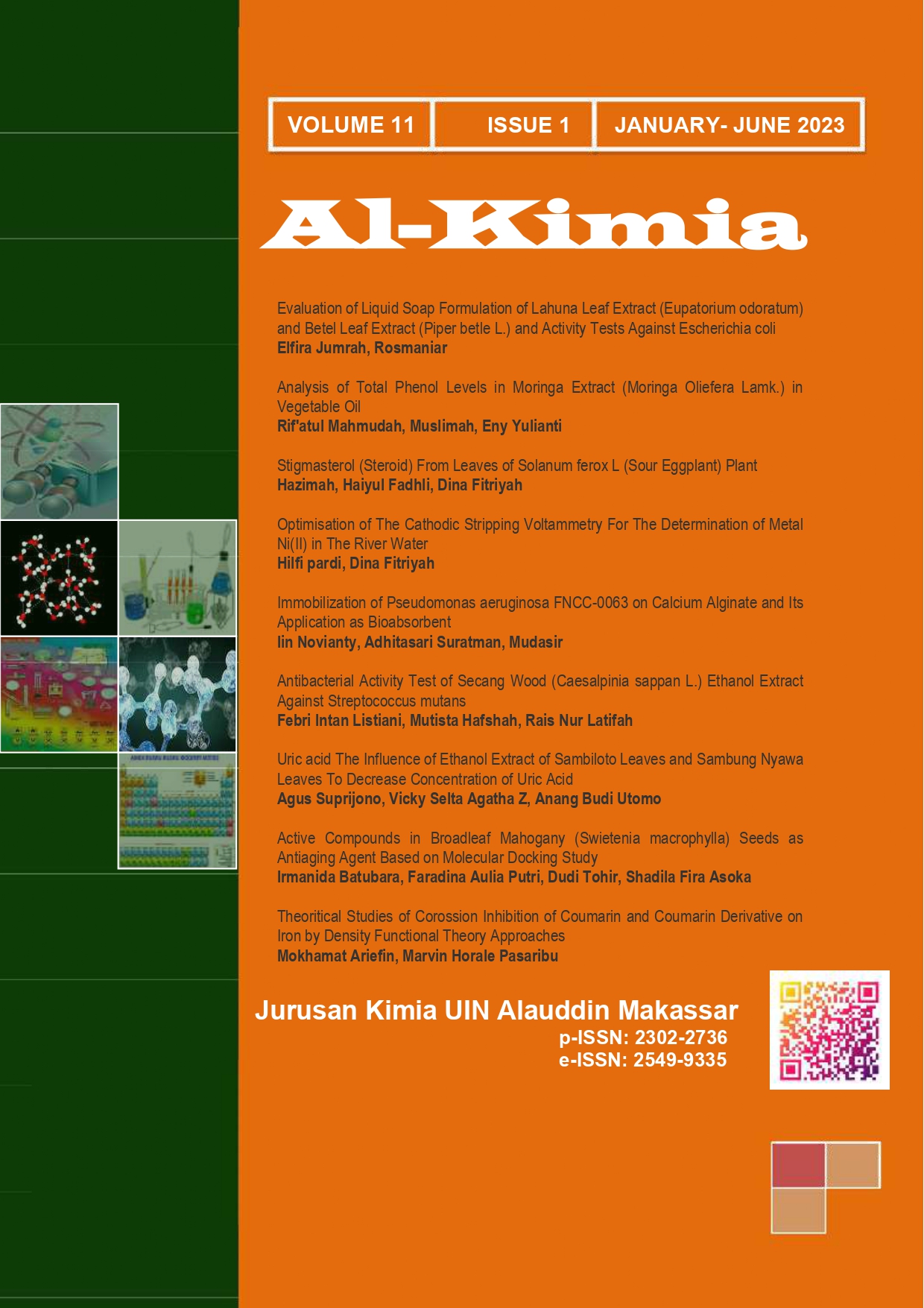Liquid Soap Formulation of Lahuna Leaf Extract (Eupatorium odoratum) and Betel Leaf Extract (Piper betle L.) and Activity Tests Against Escherichia coli
Abstract
Lahuna and betel are plants that have been used traditionally as medicine. The content of secondary metabolites in lahuna and betel leaves can be used as active compounds in the manufacture of liquid soap. This study aims to evaluate liquid soap formulations of lahuna leaf extract and betel leaf extract and to test its activity against Escherichia coli. The research method used was pH test, organoleptic test, homogeneity test, foam height test, water content test according to SNI 1996 and antibacterial activity test with agar diffusion method. The results showed that the liquid soap formulation was in accordance with SNI 1996 which was based on pH test, organoleptic test, homogeneity test, foam height test and water content test. Also, the liquid soap formulation has very strong activity against Escherichia coli characterized by a clear zone that is formed more than 19 mm
Downloads
References
Amaliah UN, Johannes E, Hassan MS, Tambaru E. 2019. The Use Extract of Siam Leaf Eupatorium odoratum L. as Alternative Material In Lowering Blood Glucose, International Journal of Applied Biology, 3(1), 15-23
Indonesian National Standard. 1996. The Standard Bath Soaps a Liquid SNI 06-4085-1996. Jakarta: A National Standards Board
Clinical Laboratory Standart Institute (CLSI). 2013. Performance Standart for Antimicrobial Susceptibility Testing. USA: Twentieth Information Supplement.
Haque AF, Mulyani E, Hendick J. 2022. Formulation of Antibacterial Hand Washing Liquid Soap with Ethanol Extract of Cayenne Pepper (Solanum frutescens.L) Leaves , Indonesian Journal of Pharmaceutical (e-Journal) , 2(2), 152-160
Hutauruk HP, Yamlean PVY, Wiyono W. 2020. Formulation and Activity Test of Celery (Apium graveolens L) Liquid Soap Ethanol Extract Against Staphylococcus aureus bacteria, PHARMACON Pharmaceutical Scientific Journal, 9(1), 73-81
Ligina AS, Sudarmin. 2022. Isolation and Identification of Secondary Metabolic Compounds from Mangrove (Rhizophora mucronata) and their Bioactivity Against Escherichia coli and Staphylococcus aureus Bacteria, Indonesian Journal of Chemical Science, 11(1), 62-68 .
Novaryatiin S, Handayani R, Chairunnisa R. 2018. Inhibitory Test of Ethanol Extract of Soil Liver Tuber ( Angiotepris Sp ) Against Staphylococcus aureus Bacteria , Journal of Surya Medika , 3(2), 23-31.
Sadiah HH, Cahyadi AI, Windria S. 2022. Study of the Potential of Green Betel Leaves (Piper betle L.) as Antibacterial, Journal of Veterinary Science, 40(2), 128-138
Sarma C, Rasane P, Kaur S, Jogindersingh JS, Gat Y, Garba U, et al. 2018. Antioxidant and antimicrobial potential of selected varieties of Piper betle L. (Betel leaf), Annals of the Brazilian Academy of Sciences, ISSN 1678-2690
Shariati A, Arshadi M, Khosrojerdi MA, Abedinzadeh M, Ganjalishahi M, Maleki A, Heidary M, Khoshnood. 2022. The resistance mechanisms of bacteria against ciprofloxacin and new approaches for enhancing the efficacy of this antibiotic, Front. Public Health, 10, 1-28. https://doi.org/10.3389/fpubh.2022.1025633
Sriwening PI, Susanti MM. 2022. Quality Quality Organic Liquid Soap Based on Castor Oil and Soda Qie, Indonesian Journal On Medical Science , 9(2), 155-160.
Widyasanti A, Winaya AT, Rosalinda S. 2019. Making Liquid Soap Made from Coconut Oil with Various Concentrations of White Tea Extract, Agrointek , 13(2), 132-142
Zar’ah NA, Syachruddin , Hj. Kusmiyati. 2021. The Effect of Green Betel Leaves (Piper betle L.) Extract on Wounding Healing in Mice (Mus musculus L.), Jurnal Biologi Tropis, 2 (1), 103–11.
Authors who publish with this journal agree to the following terms:
1) Authors retain copyright and grant the journal right of first publication with the work simultaneously licensed under a Creative Commons Attribution License that allows others to share the work with an acknowledgement of the work's authorship and initial publication in this journal.
2) Authors are able to enter into separate, additional contractual arrangements for the non-exclusive distribution of the journal's published version of the work (e.g., post it to an institutional repository or publish it in a book), with an acknowledgement of its initial publication in this journal.
3)Authors are permitted and encouraged to post their work online (e.g., in institutional repositories or on their website) prior to and during the submission process, as it can lead to productive exchanges, as well as earlier and greater citation of published work (See The Effect of Open Access).


